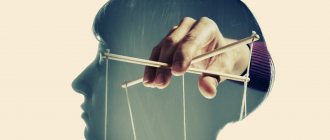Every person deceives others. According to psychologists, lying is a defensive reaction of people that helps to defend their interests and gain benefits.
Whether we like it or not, sometimes we are forced to lie even to our loved ones. Unfortunately, secrets can become apparent if you do not know how to lie correctly. In this material we will give you some tips on how to deceive a person so that he never finds out about your lie.
Many people believe that they can always see that they are being deceived. Actually this is not true.
Self confidence
Most often, a liar can be recognized by his lack of self-confidence. Internal complexes, fear, thoughts about the correctness of such an action - all this makes you nervous. As a result, non-verbal signs appear that will incriminate you: tremors of the limbs, a quiet voice, “shifty” eyes, discrepancies in facts, slurred speech, sweating and much more.
Whether it is the right thing to do or not is not important. If you decide to lie, then lie well.
Think about possible defeat
Imagine that the person you are about to lie to has exposed you. Carefully weigh the pros and cons. What do you have to say in your defense? Or maybe you just need to continue the game to finally convince your interlocutor that you are right. You must be as prepared as possible for any situation.
Training
If you want to learn how to lie plausibly, then you need to learn how to do it. Good impromptu without training is impossible.
That is why think in advance about what you will say and how you will behave. It will not be superfluous to take into account the psychological characteristics of your interlocutor so that the effect is maximum.
If you think through absolutely every detail, it will make you invulnerable.
How to stop lying to yourself? 3 useful tricks
Lying is hard because you have to deal with the fear of getting caught. Therefore, most of us are afraid to openly lie to others. But we are a master at deceiving ourselves.
People are susceptible to self-deception because they are emotionally attached to their beliefs. They begin to identify with their set of beliefs. A person deceives himself by believing something untrue in order to better convince others of it.
I've recently developed some tools to help me fool myself less. Today I would like to share them with you so that you can do the same.
Definition of self-deception
In psychology, self-deception is considered one of the popular escape methods that people use to avoid feeling guilty and to allow themselves to escape from something they do not want to face. Of course, people do not intentionally deceive themselves, but their subconscious minds come up with such tricks to protect their psychological well-being.
Busy person syndrome is one of the most common examples of self-deception.
A person who cannot achieve success in a certain field may decide to escape it by pretending to be busy. Some workaholics become this way because they were unable to establish a social life and decided to isolate themselves using this brilliant method of self-deception.
You need to be very observant to notice this pathological behavior in yourself. We lie about a variety of things, from the type of diet we prefer, to the amount of exercise we do, and even factual details about our own height and weight.
We are more likely to believe the stories we tell ourselves (both true and false) than the beliefs of others. What we like to believe is often accepted as truth. And before we know it, we're creating a wonderful narrative about those beliefs—and deceiving ourselves in the process.
Escape route...
There are times when people develop the habit of self-deception as a way to cope with problems and challenges.
An example of such self-deception would be travel. We all love to travel, but some people decide to go on a trip when something goes wrong in their personal or professional life. These people may not have been able to achieve success or develop good relationships with others, and that is why they decided to run away. A person may lie to himself, claiming that he loves to travel, but in fact he loves to escape.
Many people have a way of “fooling their inner eye” into believing that they are more successful or attractive than they actually are. Even though I may like to think otherwise, I am no exception here.
This could probably explain why we see so many lovers of photo editing apps these days. People are willing to deceive the world about their appearance, income, passion or vacation without a shadow of a doubt.
University of Michigan social psychologist David Dunning, famous for the Dunning-Kruger effect, believes that “gullibility is not a new phenomenon. But its effects are compounded in the age of social media, when false information spreads quickly. We live in a world overflowing with information and misinformation.”
…To avoid confronting difficult situations
There are people who deceive themselves so as not to face difficult situations. Avoiding a chronic problem and convincing yourself that you will solve it in the future is a common disease of procrastination.
For some people, self-deception becomes a habit that gets out of control and creates the basis for more lies. Because the best way to convince others that we believe something is to actually believe it.
- Wear the mask long enough and it will become your face.
- Play a role long enough and you will actually become what you pretend to be.
- Pretend for a long time that something is true, and you can believe it yourself.
Psychological Default Responses
We lie to ourselves because we are not strong enough to admit that we are insecure and vulnerable. We try not to face the inconvenient realities of life. We're just not ready to face them yet.
When I began my journey as a writer who works at the intersection of cognitive psychology, neuroscience, and philosophy, I was filled with doubts. I was not ready to take criticism well. I found it difficult to appreciate the importance of feedback. As a result, it was difficult to get through these initial phases of complete uncertainty.
These are the psychological default responses that protect our sense of self from complex information that can harm us.
Negation
- “I don’t eat too much, even though I’m overweight.”
- “I am not dependent on cigarettes, although my daily consumption exceeds double digits.”
- "I'm not an alcoholic, although I drink daily."
As you can see, all these statements are nothing more than a desperate attempt to deceive oneself by denying reality. Our evolutionary defense mechanism ensures that we perceive these deceptive messages as “part of us”, so it becomes difficult to find fault with them.
Rationalization
- "I wouldn't be angry with him if he kept his promise."
- “I would have a more fulfilling relationship if I had a more sensitive and emotionally stable partner.”
- “I would have pursued my passion for writing if I had more time.”
This leads to destructive behavior. The problem with this approach is that your choices are made based on deceptive messages from your brain rather than your rational and true self.
Forecasts
- “You never listen to me, you don’t care about our relationship anymore.”
- "You're too ambitious to have your own family."
- "You're too invested in your friends to value other relationships."
A prediction is how your brain makes you believe in an alternate reality. He will continue to look for opportunities to blame others. But once we accept that the problem lies with us and not with others, we have enough courage to admit who we really are and give ourselves the opportunity to make inner transformation.
How to resist self-deception
I know that discovering that you are deceiving yourself may not be very pleasant. Here's how I dealt with it when I first realized my problem, and what I've learned since then.
Once I changed my focus from writer to speaker, I suddenly found myself in completely unfamiliar territory. And this territory turned out to be too scary for a newbie like me. Among my audience were mainly schoolchildren and parents shaking over them. The former are notorious for their lack of attention, the latter for their fears of the unknown. I defined a task for myself and went towards it.
After one of the speeches, I asked the school principal to share his unbiased impressions of my sincere attempt. She said:
“Everything from the content to the form was fine, but if you want to take this activity to the next level, you need to view it as an opportunity to create an emotional connection with the audience. And this is only possible if you can adjust your text to suit the needs of your audience.”
Although I assured the director that her feedback was invaluable to me, deep down I was not brave enough to even accept it.
First, there was a feeling of denial. Primarily because of the hard work involved in preparing for the performance, which she was unaware of. Then rationalization came into play. Perhaps this portion of the students was not mature enough to appreciate the subtle nuances of my words. Perhaps the parents were not brave enough to accept difficult thoughts. And sometimes even leaders cannot appreciate such thoughts due to their prejudices.
This was nothing more than my evolutionary defense mechanism, protecting my side at all costs. When I began to try to objectively analyze these automatic reactions, I stopped myself from falling into the trap of self-deception.
These three steps helped me gain more clarity:
Pause → Check in with yourself → Look into the face of fear.
Here's how I use them, and you can do the same.
1. Pause
As soon as emotions - love, shame, revenge or guilt - manifest themselves physiologically, just pause. When you hesitate to generalize, just pause. Whenever you notice any discrepancy between your values and actions, simply pause.
Take a deep breath and stop thinking.
2. Check yourself
If you have a strong reaction to certain situations, use the pause to ask:
“What is this reaction trying to tell me?”
Once we acknowledge our limitations and uncertainties, we become aware of choices, which in turn make us more responsible for the consequences of our own actions.
3. Facing your fears
If you are avoiding something or are afraid to experience your true worth, then it is time to become brave and face what you have been running away from. What do you need to take? Once you understand this, look at it with courage. You will become much more confident in yourself.
The magic of acceptance
At the core is your willingness to accept things as they are, not as you want them to be. But accepting reality is easy when you like what you see, but you have to accept it even if you don't like it - especially when you don't. And please stop trying to force the world to conform to your will.
Perhaps you have no talent for negotiations? Are you not a natural leader or an athlete? You must be brave to accept these truths and accept the consequences.
Parting Thoughts
We often understand other people much better than we understand ourselves (which is why we are so often disappointed in others, but rarely in ourselves). Therefore, the best option is to find a friend or partner who you can rely on and who can tell you the hard but honest truth.
Even then, your brain will do its best to soften the facts it doesn't like. Over time, however, you will learn to take other people's judgments seriously.
So accept reality, and accept it radically. Especially the parts you don't like. It may be painful at the moment, but it needs to be done. This will bear fruit later.
You may have to face your fair share of failures, and it's okay to make some mistakes now and then. The key is to figure out why this happened and solve the problem at its root. Because, unlike wine, problems don't get better with age.
Source
Interesting article? Subscribe to our Telegram channel to receive more educational content and fresh ideas.
Tell the truth
According to scientists, it is impossible to expose lies that are based on some shocking truth. Confirm what is said with known facts from your life that your opponent has already heard about. You can also reinforce this with the phrases “to be honest”, “it was not easy to talk about this now, but I believe you will understand me”, etc.
Consider the personality of the person you are lying to.
Always adapt to the victim. Feel what is going on in your interlocutor's head and adapt to his emotions. A different lie needs to be applied to each person.
If you are caught doing something, repeat until the last moment that “it didn’t happen” and “it just seemed to you.” Don't make excuses. On the contrary, make a surprised face.
The human psyche is designed in such a way that sooner or later he will believe it.
Facial expressions
According to Vladislav Zigaev, if emotions can also be learned to control, then with microexpressions we are almost powerless. This is a momentary involuntary facial expression that people unconsciously show when hiding emotions. Microexpressions appear for a fairly short time and are made involuntarily, they are almost impossible to control.
“They often say about a lying person that “a shadow ran across his face.” This tension on the face lasts literally 1–2 seconds. The manifestation of instant tension in the facial muscles is an accurate indicator of insincerity. It is also worth paying attention to the appearance of an involuntary reaction on the skin and other parts of the interlocutor’s face. This takes into account a change in the color tone of the skin (the interlocutor will blush or turn pale), the pupils dilate, the lips tremble, and both eyes blink frequently,” says physiognomist Shamil Sharinsky.
Correct behavior
Always look your interlocutor in the eyes: not intently, but boldly. Smile and be calm. Do not fiddle with anything, do not scratch or shift from foot to foot. Don't raise your voice.
Wave your arms. This will distract the interlocutor from other factors by which a lie can be determined.
The most functional accessory
A joint team from the Tokyo National Institute of Information Science and the Tokyo University of Technology created glasses in 2013 that incorporate infrared LEDs. In infrared, camera LEDs turn your face into a blur of light. It’s safer, perhaps, to shine a laser beam directly into the camera, but for this you need to clearly hit the lens.
A more advanced solution in 2015 was the Privacy Visor glasses (pictured on the left). They are equipped with a complex system of lenses that reflect, refract and absorb light. The technology prevents the camera from focusing and “blurs” the area around the eyes, showing it much brighter. The system detects a person wearing regular sunglasses, but cannot identify the owner of the Privacy Visor.
https://www.youtube.com/watch?v=CA3ix3zt9bo In 2021, a startup emerged that successfully raised the amount needed on Kickstarter to produce glasses that use miniature LEDs and a mini-battery. Glasses are a little suspect if you wear them at night, but they are definitely safer than the laser method (nothing looks weirder than a person poking a pointer at the camera).











